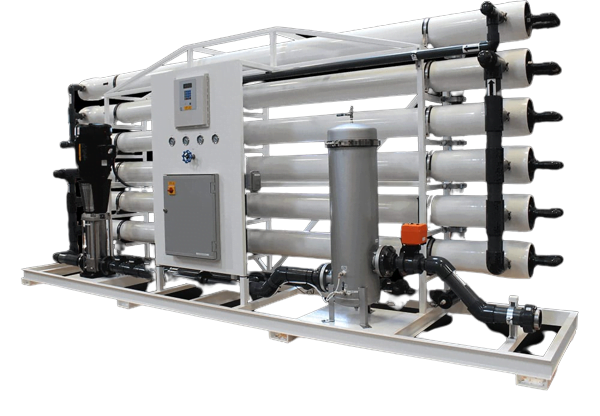Brackish Water Ro System in UAE | Ro Water Plants | Industrial Ro System In UAE
Brackish Water Ro System in UAE

Brackish water has moderate levels of dissolved minerals and salts. The absence of this Purification makes the water less desirable or unusable for many weaknesses.
Aqua Best brackish water RO systems are designed with performance and ease of operation in mind. Our systems produce water to meet the most demanding specifications and different capacities are available to suit specific requirements.
We also assemble container Systems. Our systems are built into brand-new 20- and 40-foot containers that meet international quality standards. They arrive at your facility ready to operate with pre and post-treatment systems, pumps, piping, and controls.
Our containers water treatment systems offer safety and arm to meet the operational requirements of new generation plants, municipalities, the building industry, manufacturing plants, resorts, and others.
- 1500 Brackish Water RO Plant
- 3000 Brackish Water RO Plant
- 5000 Brackish Water RO Plant
- 6000 Brackish Water RO Plant
- 10000 Brackish Water RO Plant
- 12000 Brackish Water RO Plant
- 15000 Brackish Water RO Plant
- 20000 Brackish Water RO Plant
- 40000 Brackish Water RO Plant
- 60000 Brackish Water RO Plant
- 80000 Brackish Water RO Plant
- 100000 Brackish Water RO Plant
How many ppm is brackish water?
Brackish water is water that has more salinity than freshwater, but not as much as seawater. Salinity expresses the saltiness or dissolved salt content of a body of water. Technically, brackish water contains between 500 and 30,000 ppm salt, usually expressed as 0.05 – 3.0 %.
Brackish water, which is less salty than seawater, requires less treatment to be used as drinking water
Brackish water is water with salinity levels between seawater and freshwater. It occurs where surface or groundwater mixes with seawater, in deep “fossil aquifers,” and where salt dissolves from mineral deposits over time as precipitation percolates down into aquifers. Historically, brackish water has been undervalued. While it may be used for irrigation in some parts of the world, most industries can’t use it because it damages equipment, and it’s not fit for consumption by humans or livestock.
But as the cost of desalination has decreased and freshwater resources have become radically depleted, many decision-makers are giving the desalination of brackish water a second look. Brackish water is, after all, significantly easier to desalinate than seawater.
Defining Salinity
Salinity is the level of salt in water, and it is determined by measuring the total dissolved solids (TDS) through evaporation and weighing or with a more convenient but less accurate electrical conductivity (EC) test, which measures how easily electric current passes through the through the water.
Salt in brackish water is not just sodium chloride. Other compounds that may occur in brackish water include:
- Sodium
- Potassium
- Calcium
- Magnesium
- Chloride
- Sulfate
- Bicarbonate
- Carbonate
- Nitrate
Brackish Groundwater
Whatever the definition, there is a great amount of salty water worldwide that cannot be used without desalination.
According to the USGS, very salty groundwater abounds in the western United States, perhaps leftover from ancient seas or from contact with soluble minerals in the ground. In New Mexico, about three-quarters of all groundwater is too salty to be used for most purposes without treatment.
Research has shown that much more groundwater is brackish than previously believed. In 2018, Ferguson et al reported that transitions in aquifers — from the higher freshwater zones to the lower, more saline zones — are much closer to the surface than surmised. That means deeper drilling is not the option that many have counted on.
The discovery of an expansive, 15,000-square-mile brackish aquifer under the seabed stretching from just off Ocean County, New Jersey, to Martha’s Vineyard, Massachusetts, the largest known of its kind, may predict that other such offshore aquifers may be plentiful throughout the world. Although the situation in the Northeastern U.S. does not favor brackish desalination at this time, such an aquifer could be a viable resource in an area facing water stress.
Saltwater Intrusion
Because freshwater municipal drinking and agricultural irrigation water wells often draw from groundwater supplies, contamination by saline water poses a global threat, particularly near coastlines, where nearby seawater is drawn in to fill the void.
Roughly half of the world’s population lives within 200 km of a coastline. Areas in the U.S. already experiencing saltwater intrusion include coastal California, New Jersey, Florida, and New York. Globally it is happening in cities along the Laizhou Gulf in China; in Manila, Philippines; and Perth, Australia. In the Maldives, the island of Thoddoo is using a combination of rainwater harvesting and desalination to protect its aquifers from overexploitation.
The Maldives case provides a good example of a populated island in need of public potable water supplies. Often the available feed water in island communities is both saline and brackish, depending on the source. Well water, for example, is frequently brackish.
Reverse Osmosis Desalination of Brackish Water
Another example can be found on the island nation of Cyprus, where groundwater supplies for the city of Limassol were too brackish for drinking, and had high nitrate levels. In Garillis, Fluence constructed a desalination plant for Cyprus Water Development using brackish water reverse osmosis (RO) to produce 10 million L/d of high-quality drinking water.
